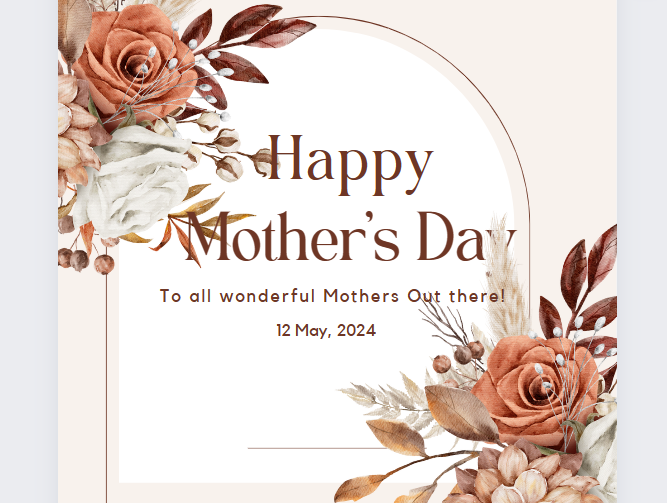‘Mother’s Day is an invention of the flower trade’, say many, but that’s not true. In fact, the ancient Greeks and later the Romans honoured their mothers. However, the founder of today’s Mother’s Day is considered to be the American Anna Marie Jarvis, who established an official holiday to honour mothers in the USA in 1914.
The history of Mother’s Day is old: a kind of Mother’s Day festival was held for Roman and Greek goddesses as early as 250 years before Christ. In the 13th century, Henry III introduced the so-called ‘Mothering Day’ in England, established in England around 1644. Napoleon also proposed the establishment of a Mother’s Day in 1806 but never got around to realising his plan.
Anna Marie Jarvis: The Mother of Mother’s Day
The history of Mother’s Day as we know it today began at the end of the 19th century. In 1865, the American Ann Maria Reeves Jarvis founded a mothers’ movement called “Mothers Friendship Day” and organised “Mothers Day Meetings” as an exchange platform for mothers during the American Civil War. In 1870, the poet Julia Ward Howe caused a sensation with her ‘Mothers’ Day Proclamation,” a proposal to introduce Mother’s Day as a day of protest against the war.
When Ann Maria Reeves Jarvis died in May 1905, her daughter Anna Marie Jarvis wanted mothers to be honoured while they were still alive, not just after their deaths. Two years after the anniversary of her mother’s death, she organised a memorial service for her in Grafton. She asked the priest to explain the role of mothers in society in his sermon. And thanks to Jarvis’ efforts, a service was dedicated to all mothers in Grafton on the second Sunday in May the following year.
‘Let flowers speak’
Jarvis also launched a publicity campaign to establish an official holiday in honour of mothers; by 1909, Mother’s Day was celebrated nationwide. In 1914, Mother’s Day was finally declared a bank holiday by the US Congress. Mother’s Day spread worldwide but was soon taken over by commerce.
However, this was not to Jarvis’ liking, who vehemently opposed the commercialisation of Mother’s Day. However, she was unable to stop its spread. Incidentally, Jarvis died in 1948 without ever having become a mother herself.
However, giving flowers was apparently Jarvis’ idea, and she is said to have coined the slogan: “Let flowers speak”. At her mother’s funeral, she is said to have distributed 500 white and red carnations among those attending the service—red carnations for living mothers, white for those who had already passed away. The carnation is said to have been her mother’s favourite flower.
Flowers are popular Mother’s Day gifts, so the day also became an important economic factor for the flower trade. However, the holiday was not invented by her.
Introduced in Austria in 1924
Mother’s Day was introduced in Austria in 1924 on the initiative of women’s rights activist Marianne Hainisch. The mother of then-Federal President Michael Hainisch was the founder of the Austrian women’s movement. However, Mother’s Day was soon instrumentalized by National Socialism.
According to the provincial archives, the Christian Socialists in Vorarlberg cultivated an image of a mother based on Jesus’ mother, Mary; the Greater Germans emphasised the national significance of “German Mother’s Day,” while the Social Democrats rejected the bourgeois invention.
Used by the Nazis for their purposes
During the authoritarian phase of the Third Reich from 1933 onwards, the Mother’s Protection Organization of the Patriotic Front used Mother’s Day for ‘family renewal’ and the fight against the declining birth rate, according to the website of the National Archives. In 1934, the ‘Day of Remembrance and Honor of German Mothers’, now on the third Sunday in May, was already an integral part of the Nazi year of celebration. ‘German-blooded’ and ‘hereditary’ mothers of four or more children were awarded ‘Mother’s Crosses’ on this occasion from 1939.
During the war years, the Nazi cult of motherhood took on a martial flavour, according to the state archives. On Mother’s Day, 1941, Adolf Hitler declared that a woman was fighting for her nation with every child she gave birth to.
Public holiday on the second Sunday in May
After the Second World War, stationed Americans also ensured that Mother’s Day was celebrated again with its former significance in Western Europe. In recent decades, Mother’s Day has once again become a day mothers are honored for their love and all the work they invest in the family.
However, the day is not a public holiday in Austria, for example, and it is not celebrated on the same day worldwide. While the British, for example, celebrate it on the fourth Sunday before Easter, in Austria and the USA, it is celebrated annually on the second Sunday in May. Just like in Anna Marie Jarvis’ day.
- source: orf.at/picture: canva.com
This post has already been read 4058 times!



